Related Topics
Art in Philadelphia
The history of art, particularly painting and sculpture, has been a long and distinguished one. If you add in the art schools, the Philadelphia national influence on artists has been a dominant one.
Particular Sights to See:Center City
Taxi drivers tell tourists that Center City is a "shining city on a hill". During the Industrial Era, the city almost urbanized out to the county line, and then retreated. Right now, the urban center is surrounded by a semi-deserted ring of former factories.
Customs, Culture and Traditions
Abundant seafood made it easy to settle here. Agriculture takes longer.
Architecture in Philadelphia
Originating in a limitless forest, wooden structures became a "Red City" of brick after a few fires. Then a succession of gifted architects shaped the city as Greek Revival, then French. Modern architecture now responds as much to population sociology as artistic genius. Take a look at the current "green building" movement.
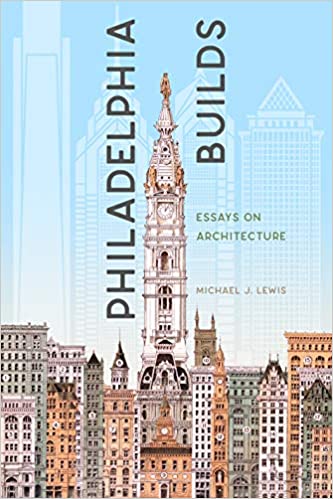
Wall Art in Philadelphia
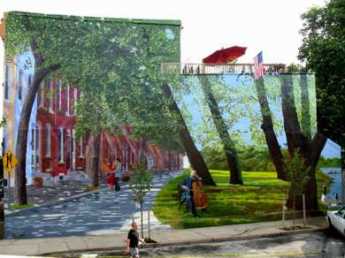
|
| Seasons |
At last count, Mural Arts program of the city government of Philadelphia has sponsored and paid for 2700 large paintings on the walls of buildings around town, and several hundred more have appeared spontaneously. Comparatively few art museums have that many on display, so people are proud of the Philadelphia effort.
This program is now nearly thirty years old, beginning to emerge as a national treasure. Looking back, it is pleasing that it had humble, even deplorable, origins. As American cities lost their industrial focus, many homes in the neighborhood of former factories have been abandoned, getting torn down in random patterns. Industrial cities of the East Coast were tightly packed to save land costs and time commuting to work; the fashion of "row houses" evolved without any space between neighbors sharing a "party" wall. When a row house was torn down, there emerged a scabrous ghost, because the wallpapered interior walls were exposed and looked pretty hideous. It eventually became illegal to leave a scabrous building, leading to elaborate legal conventions about responsibility for the cost of covering exposed surfaces with concrete stucco. During the last half of the Twentieth Century, stucco was generally an improvement.
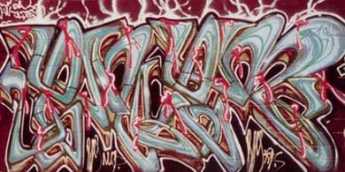
|
| Graffitti |
Meanwhile, during World War II it became clever for American military to inscribe "Kilroy was here" on unprotected public surfaces at home and abroad as a gesture of American triumphalism. Opinions differ about whether this started originally as an allusion to a certain line of 19th Century romance poetry, or whether there was in fact a John J. Kilroy, inspector of riveting in wartime shipyards, marking riveted materials with his name to enable piecework payment for shipyard tasks. Eventually, this Kilroy joke became a little tiresome, but soon was replaced by stylized decorations using cans of spray paint, until "graffiti" painting, in turn, became a public nuisance. It is true some graffiti artists were quite talented, but the associated vandalism of teenagers added a threatening quality to public defacement of property belonging to others. By implication, an area with graffiti was a home of lawlessness and that implication cast a negative shadow on the city economy. Public opinion demanded something effective be done to stop it.
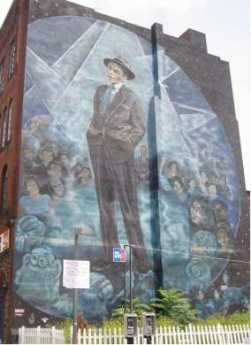
|
| Frank Sintra |
Since graffiti vandalism has declined nationwide in the past twenty years, it is difficult to claim that one public initiative in Philadelphia cleaned it up. But it might be true. Then-Mayor Wilson Goode formed an antigraffiti Network, essentially a think tank for concerned citizens, floundering about for a solution to an appalling problem. Somehow the inspired idea arose that the graffiti artists might be channeled into better directions if given professional art lessons, and working materials. A West-Coast artist named Jane Golden was hired to supervise what has become a multimillion-dollar project, overseen by some sort of guiding hand pushing the whole city into becoming part of a gigantic art project. Guides tell visitors that there are fifty employees involved in publicity and legal work, organizing artists, fundraising, organizing teams of painters at all levels of competence, helping oversee the general appropriateness of what is happening. And at the head of this team is Jane, a tornado of energy.
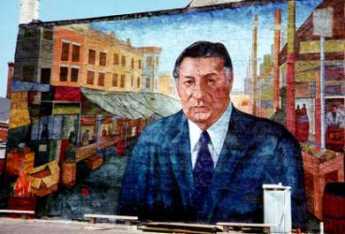
|
| Frank Rizzo |
It costs forty to seventy thousand dollars to produce one of these works, and since they are exposed to the weather, they only last about fifteen years. There are several techniques for transforming a small artwork into a big outdoor copy, some of them tracing back to Michaelangelo. Most of the Philadelphia murals are produced by dividing the original small artwork into squares and transferring numbered squares to the wall, one inch to one foot. As you can see by reviewing some of the websites devoted to the topic, a piece of art which is quite appealing can sometimes change into a drab mess when its size is blown up to three-story height. The problems of lighting such work are quite different from the lighting of a gallery painting. The surface is seldom smooth, so the bumps and grooves of the underlying scabrous "canvas" can destroy, or sometimes dramatically enhance, a salon painting. If you get too close, you can't see all of it, and that may be a problem. It's probably not entirely predictable what will come out in the final product.
There are inevitably political problems as well. The best examples are the several paintings of former Mayor Frank Rizzo, who is a hero to the Italian neighborhoods where they stand, but provoke riotous feelings in near-by black districts. Luck alone has confined the antagonisms to graffiti on the murals, viewed by some groups as enhancements on what begins as graffiti. No wonder the committees assigned to approving locations can take a long time to come to a decision.
There's another problem, which seems to be embedded in the situation. In the central city skyscraper district, you don't have scabrous buildings. Nor can mural art be placed in the historic square mile. Just a few blocks in either direction from central city there are plenty of demolitions and scabrous walls, but, close to downtown, these are areas of gentrification and urban renewal. It doesn't make sense to spend fifty thousand dollars to paint a wall which will be demolished in two or three years. The net effect is that the city may have three thousand paintings all right, but only fifty at most are within a tourist ride of Independence Visitors Center. If half of these fifty are concerned with celebrating local heroes unfamiliar to tourists, there can be disappointment which would disappear if a selection of fifty outstanding products could be culled from three thousand -- and grouped together for exhibition.
A solution to these issues will surely emerge with time, but it will evolve, not be envisioned.
Originally published: Tuesday, May 29, 2007; most-recently modified: Wednesday, May 29, 2019
| Posted by: Santo Musumeci | Nov 10, 2011 7:50 PM |
Where can I see on line the art that is on the wall at 2nd and Christian
Street here in Philadelphia? It has
a hidden picture of Sherlock Holmes
on it.
Thank you.
| Posted by: Santo Musumeci | Mar 24, 2010 7:44 PM |
I have an idea for a wall.
| Posted by: Santo | Oct 4, 2008 7:12 PM |
Do you do the paintings on Philadelphia buildings?
I have an idea for one.
| Posted by: Santo Musumeci | Sep 28, 2008 10:05 AM |
| Posted by: Granny | Apr 12, 2008 1:36 PM |
How about doing one of Elvis Presley?
I have a location and can email it to you if you like. Please advise.